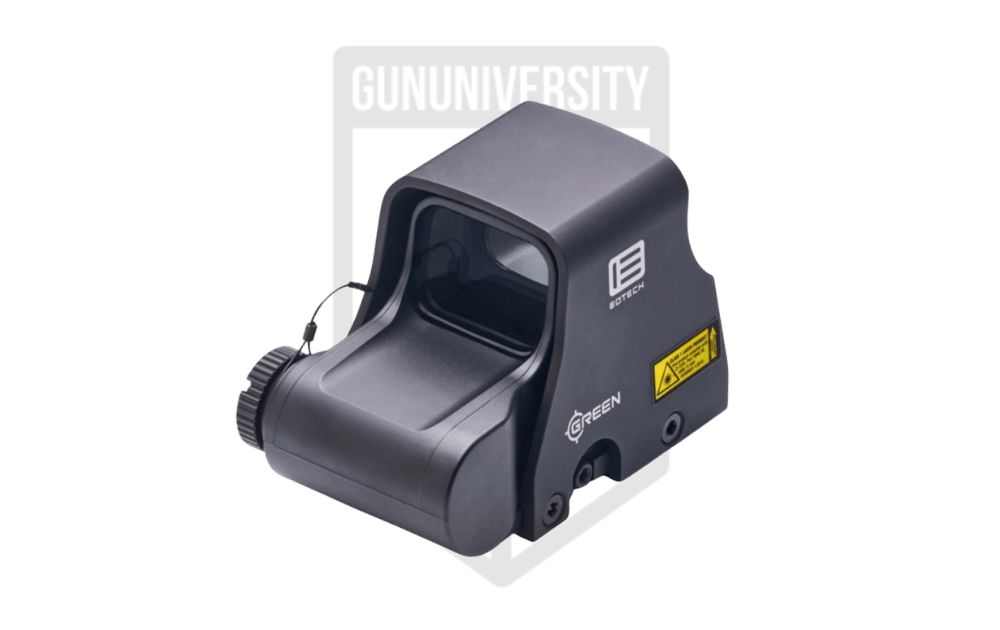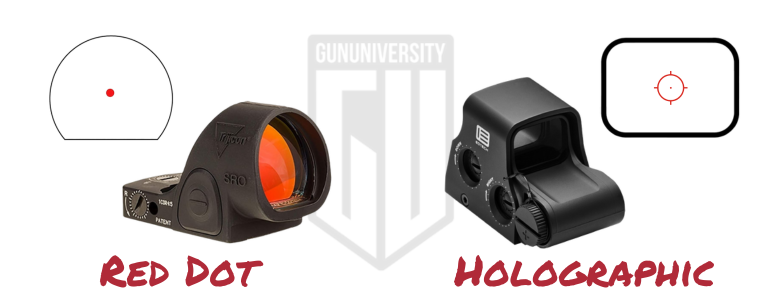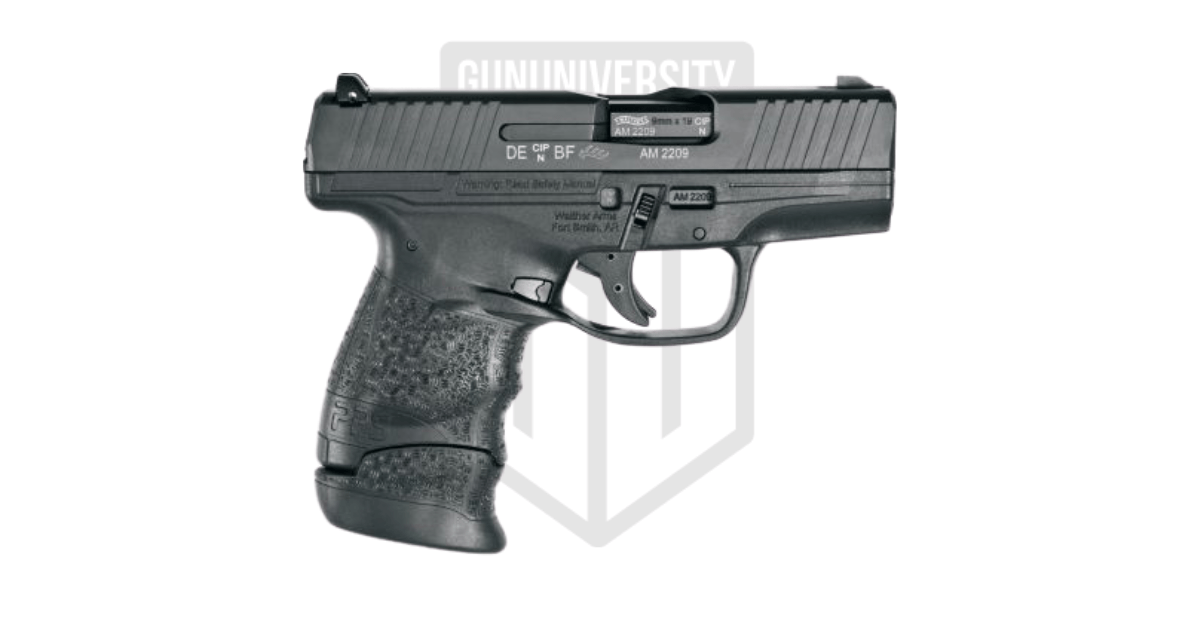Red Dot vs. Holographic Sights: Which Is Best For You?
Is it better to use a red dot sight (RDS) or a holographic sight? When you see one of these little optics being advertised, do you understand the difference? We’re here to explain the difference and help you figure out which is better. Consider us your one-stop spot for all things RDS and holographic.
Now, we’re not comparing specific brands, only the type of reticle on these sights. However, we are going to provide some brand-specific comparisons just to give you a general idea of how these sights work.
Spec Comparison
Trijicon SRO
- MSRP : $771.00

Eotech XPS2
- MSRP : $629.00
What they have in common
As you might have guessed, red dot sights and holographic sights have a lot in common. Using our example models, you can see the SRO and XPS2 both have 1x magnification and similar window sizes. Each has an aluminum housing and features a red illuminated reticle of some sort. Per click values vary, but that has more to do with the specific model than the type of sight (same goes for the brightness settings, that’s just model specific).
Both red dot sights and holographic sights are usually significantly smaller than scopes; although there are scopes with red dots incorporated into them. These are compact sights designed for close range use, although it is possible to combine many of these sights with magnifiers to increase effective range. They’re also both quite popular for use on long guns, but there are far more red dots for handguns than there are holographic sights. Also, people use both red dots and holographic sights for everything from self-defense to hunting to competition, and more. On the surface, it seems like they have a lot more in common than they do differences.
The most notable difference
At first glance, the most obvious difference in red dots vs. holographic sights is the reticle. On a red dot, it’s simply a dot, whether it’s red or green. But on a holographic sight, you have a ring around a dot. From a basic standpoint, that’s it. That’s the difference. In reality, those differences run far deeper and have to do with the way the sights work and how your eye perceives them.
Red dot sights function thanks to an LED emitter. These dots have a spherical mirror set at an angle that reflects the light. It’s coated so that only red light—or green, in some cases—can pass through the glass. You can see the red dot on your side of the sight, but the dot isn’t going to be visible from the other side. This type of sight is not magnified and is most effective at closer ranges. Some red dot sights have adjustable dot sizes, which is handy because it allows you to change the dot size according to the target and situation.
As for holographic sights, they work differently than red dot sights. They use the same technology as a hologram and use lasers rather than an LED. The system behind the holograph is fairly complex and involves the use of lasers and mirrors to create the image of the reticle. Much like a red dot, this holographic projection is visible to the user and cannot be seen from the other side. The projection could be a variety of shapes and sizes and can be two or three dimensions. According to EOTech, they use technology similar to what is used by fighter pilots. You could say it’s relatively complex.
What does this mean? The red dot is the simplest of the two. A straightforward mirror system creates a red dot sight’s focusing dot, while a holographic sight’s projection is created through the use of layers of laminate and glass and laser diode technology. The precise details tend to depend on the manufacturer, but the basics remain the same.

Reticles and Brightness
There is a difference between reticles with red dot vs. holographic sights. The former has a dot, while the latter often has a dot surrounded by a circle. There are pros and cons to each, and we’re going to get into those later. As for brightness, that’s the next question when you’re considering red dot vs. holographic sights. Does brightness vary by type of sight or is it model specific?
Brightness of red dots vs. holographic sights varies by model. That doesn’t mean your eye might not perceive the types differently, only that brightness can be adjusted on both types. One is not inherently brighter than the other, just different. The brightness level you choose will depend on the environment and the target. Also, both red dots and holographic sights can be more difficult to see in bright light, requiring you to increase brightness.
Adjustments
Using our example sights, we have the Trijicon SRO with a 1 MOA per click adjustment and the EOTech XPS2, which has a 0.5 MOA per click adjustment. You’ll find red dots and holographic sights with different per-click ranges just like any other optic. The specific adjustment isn’t really related to the type of sight, it’s just how the manufacturer designed it.
Power Source
This is where a significant difference between red dot and holographic sights comes up: power. Red dot sights don’t require that much power to function. For example, the Trijicon SRO takes a single CR2032 battery and can last up to three years (depending on settings, of course). However, the EOTech XPS2 takes a single CR123A and lasts up to 1000 hours. Those 1000 hours are equivalent to about 41.67 days. And, as with any sights, actual lifetime depends on the settings being used. It takes more power to keep a holographic sight going than a red dot.
Controls
The controls for red dot vs. holographic sights are the same. The specifics of the buttons and turrets are model specific, but they don’t drastically change due to type of sight. Personally, we prefer adjustment buttons and turrets with crisp, precise clicks. Mushy adjustments aren’t very helpful and make it difficult to discern just how many times you’ve turned or pushed the controls. This is another manufacturer and model-specific feature rather than one related to the type of sight. When it comes to red dot vs. holographic sights, do homework on the specific models to find out exactly how well the various controls work.
Durability and Longevity
Durability is something that must be considered when deciding red dot vs. holographic sights. If the holographic sight’s glass is partially broken or it’s obscured, it’ll keep working. As for red dots, they tend to function better than holographic sights in extreme temperatures. You might expect a holographic sight to break a lot easier than a red dot sight, but that isn’t necessarily true. It’s accurate to say most holographic sights are going to be a bit more sensitive than red dots, but that doesn’t mean they’re prone to breaking.
Both red dot sights and holographic sights can, and do, break. LEDs fail, laser diodes break, and entire pieces of glass fall out. It’s also true that the housing can be damaged and bent, but the red dot keeps on working. We can break either type of sight, and the true durability and longevity of a sight is more about how it’s made than anything else. Of course, holographic sights tend to be significantly more expensive to replace.
Red dot vs. Holographic Sights: Our Take
If you’re running a pistol, you’re probably going to be using a red dot sight. There just aren’t micro holographic sights yet, so while you could technically put a bulkier sight on a large enough handgun, it’s not likely to be ideal. There are also far more red dots out there. EOTech and Vortex manufacture the vast majority of holographic sights. However, a ridiculous number of companies manufacture red dots. You simply have more options with red dots.
Something else to consider is whether you have an astigmatism. If you do, you might have found out that red dots end up distorted by halos or sunbursts, making them almost impossible to use with consistent accuracy. Utilizing a green or yellow dot instead can solve that issue, but here’s another idea: try a holographic sight. Holographic sights can be easier to see for shooters with astigmatism due to the different way in which they create the reticle.
Also, take a moment to decide what you’re using the sight for. In some cases, the red dot is more likely to obscure the target, making it difficult to get an accurate shot. This is especially an issue while hunting. Holographic sights offer the benefit of that ring around the dot and a greater field of view. Of course, there are shooters who feel the trade-off for the field of view with a holographic sight means sacrificing other aspects of your vision. This is because you’re focusing on that broader window.
In the end, it comes down to personal preference and use. And really, until there’s a wider selection of holographic sights on the market, red dots will probably continue to rule the day. See our reviews on the best red dots.
Important Links and Videos
Here are some links to the website for each product we used as examples along with a Youtube review of each.
Here is a video how to care for you Glock pistol.
Recent Posts
December 15, 2025
December 15, 2025
December 12, 2025
December 12, 2025




